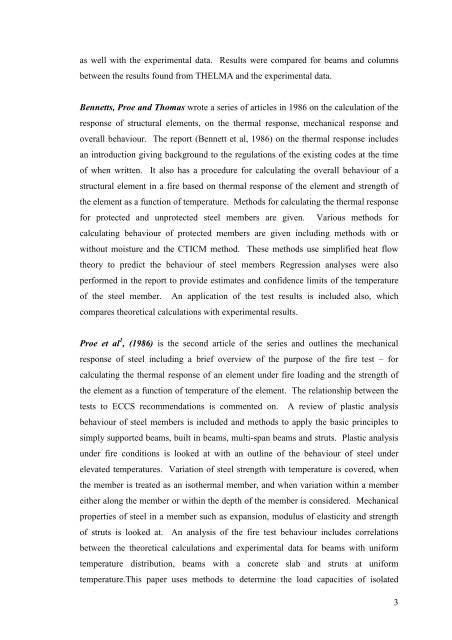FIRE DESIGN OF STEEL MEMBERS - Civil and Natural Resources ...
FIRE DESIGN OF STEEL MEMBERS - Civil and Natural Resources ...
FIRE DESIGN OF STEEL MEMBERS - Civil and Natural Resources ...
Create successful ePaper yourself
Turn your PDF publications into a flip-book with our unique Google optimized e-Paper software.
as well with the experimental data. Results were compared for beams <strong>and</strong> columns<br />
between the results found from THELMA <strong>and</strong> the experimental data.<br />
Bennetts, Proe <strong>and</strong> Thomas wrote a series of articles in 1986 on the calculation of the<br />
response of structural elements, on the thermal response, mechanical response <strong>and</strong><br />
overall behaviour. The report (Bennett et al, 1986) on the thermal response includes<br />
an introduction giving background to the regulations of the existing codes at the time<br />
of when written. It also has a procedure for calculating the overall behaviour of a<br />
structural element in a fire based on thermal response of the element <strong>and</strong> strength of<br />
the element as a function of temperature. Methods for calculating the thermal response<br />
for protected <strong>and</strong> unprotected steel members are given. Various methods for<br />
calculating behaviour of protected members are given including methods with or<br />
without moisture <strong>and</strong> the CTICM method. These methods use simplified heat flow<br />
theory to predict the behaviour of steel members Regression analyses were also<br />
performed in the report to provide estimates <strong>and</strong> confidence limits of the temperature<br />
of the steel member. An application of the test results is included also, which<br />
compares theoretical calculations with experimental results.<br />
Proe et al 1 , (1986) is the second article of the series <strong>and</strong> outlines the mechanical<br />
response of steel including a brief overview of the purpose of the fire test – for<br />
calculating the thermal response of an element under fire loading <strong>and</strong> the strength of<br />
the element as a function of temperature of the element. The relationship between the<br />
tests to ECCS recommendations is commented on. A review of plastic analysis<br />
behaviour of steel members is included <strong>and</strong> methods to apply the basic principles to<br />
simply supported beams, built in beams, multi-span beams <strong>and</strong> struts. Plastic analysis<br />
under fire conditions is looked at with an outline of the behaviour of steel under<br />
elevated temperatures. Variation of steel strength with temperature is covered, when<br />
the member is treated as an isothermal member, <strong>and</strong> when variation within a member<br />
either along the member or within the depth of the member is considered. Mechanical<br />
properties of steel in a member such as expansion, modulus of elasticity <strong>and</strong> strength<br />
of struts is looked at. An analysis of the fire test behaviour includes correlations<br />
between the theoretical calculations <strong>and</strong> experimental data for beams with uniform<br />
temperature distribution, beams with a concrete slab <strong>and</strong> struts at uniform<br />
temperature.This paper uses methods to determine the load capacities of isolated<br />
3
















